小升初英语总复习——词汇 句型 语法
- 格式:doc
- 大小:604.50 KB
- 文档页数:17
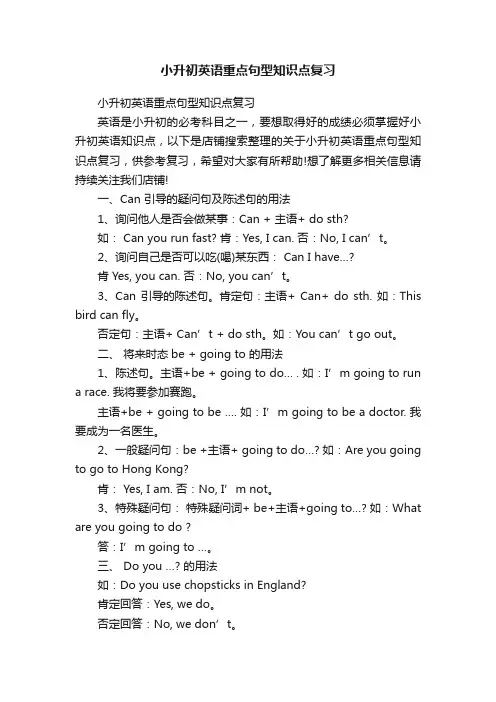
小升初英语重点句型知识点复习小升初英语重点句型知识点复习英语是小升初的必考科目之一,要想取得好的成绩必须掌握好小升初英语知识点,以下是店铺搜索整理的关于小升初英语重点句型知识点复习,供参考复习,希望对大家有所帮助!想了解更多相关信息请持续关注我们店铺!一、Can 引导的疑问句及陈述句的用法1、询问他人是否会做某事:Can + 主语+ do sth?如: Can you run fast? 肯:Yes, I can. 否:No, I can’t。
2、询问自己是否可以吃(喝)某东西:Can I have…?肯 Yes, you can. 否:No, you can’t。
3、Can 引导的陈述句。
肯定句:主语+ Can+ do sth. 如:This bird can fly。
否定句:主语+ Can’t + do sth。
如:You can’t go out。
二、将来时态be + going to 的用法1、陈述句。
主语+be + going to do… . 如:I’m going to runa race. 我将要参加赛跑。
主语+be + going to be …. 如:I’m going to be a doctor. 我要成为一名医生。
2、一般疑问句:be +主语+ going to do…? 如:Are you going to go to Hong Kong?肯: Yes, I am. 否:No, I’m not。
3、特殊疑问句:特殊疑问词+ be+主语+going to…? 如:What are you going to do ?答:I’m going to …。
三、Do you …? 的用法如:Do you use chopsticks in England?肯定回答:Yes, we do。
否定回答:No, we don’t。
这个句型是在询问某人是否做某事的情况下用的,在回答这类疑问句时,注意人称和肯定、否定用法就可以了。

小学英语升初中必背的句型及词汇归类一、一般疑问句:1、Did you read books? 你读书了吗?Yes, I did.是的,我读过了。
No, I didn’t. 不,我没有读过。
2、Is she quiet? 她文静吗?No, she isn’t. She’s very active. 不,她不。
她很活跃。
Is she strict? 她严格吗?Yes, she is, but she’s very kind.是的,她是,但是她很和蔼。
3、Is this a teacher’s desk? 这是一张讲台桌吗?Is it cold? 冷吗?Is that your pencil?那是你的铅笔吗?Is her birthday in June? 她的生日在六月吗?Is this your T-shirt? 这是你的T恤衫吗?这几种Is开头的答句都是:肯定回答:Yes, it is. 是的。
否定回答:No, it isn’t. / No, it’s not. 不,不是的。
用it来代替这个this 和那个that4、Can you make the bed? 你会铺床吗?Can you use a computer? 你会使用电脑吗?Yes, I can. 是的,我会。
No, I can’t. 不,我不会。
5、Are they ducks? 它们是鸭子吗?Are they eating the honey? 它们吃蜂蜜吗?Are those your shoes? 那是你的鞋子吗?Are these your pants? 那是你的裤子吗?这几种句型的回答都是:肯定回答:Yes, they are. 是的,它们是。
否定回答:No, they aren’t. 不,它们不是。
用they来代替这些these和那些those6、Is there a forest in the park? 公园里有一个森林吗?Is there a river?那里有条河吗?Yes, there is. 是的,那里有。
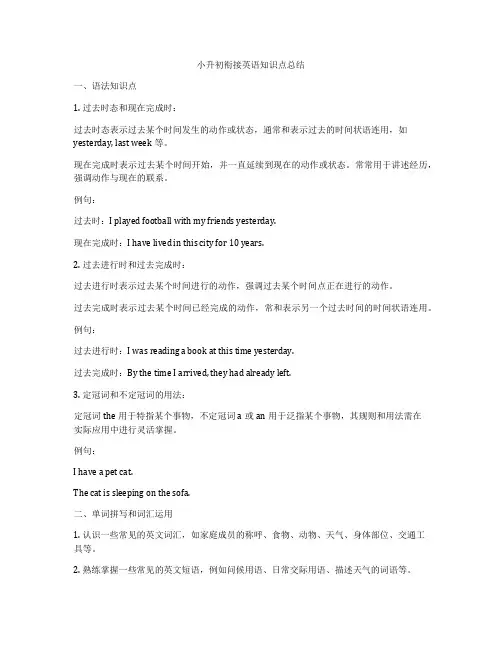
小升初衔接英语知识点总结一、语法知识点1. 过去时态和现在完成时:过去时态表示过去某个时间发生的动作或状态,通常和表示过去的时间状语连用,如yesterday, last week等。
现在完成时表示过去某个时间开始,并一直延续到现在的动作或状态。
常常用于讲述经历,强调动作与现在的联系。
例句:过去时:I played football with my friends yesterday.现在完成时:I have lived in this city for 10 years.2. 过去进行时和过去完成时:过去进行时表示过去某个时间进行的动作,强调过去某个时间点正在进行的动作。
过去完成时表示过去某个时间已经完成的动作,常和表示另一个过去时间的时间状语连用。
例句:过去进行时:I was reading a book at this time yesterday.过去完成时:By the time I arrived, they had already left.3. 定冠词和不定冠词的用法:定冠词the用于特指某个事物,不定冠词a或an用于泛指某个事物,其规则和用法需在实际应用中进行灵活掌握。
例句:I have a pet cat.The cat is sleeping on the sofa.二、单词拼写和词汇运用1. 认识一些常见的英文词汇,如家庭成员的称呼、食物、动物、天气、身体部位、交通工具等。
2. 熟练掌握一些常见的英文短语,例如问候用语、日常交际用语、描述天气的词语等。
3. 掌握一些常见的英文俚语和谚语,能够在日常生活中使用,更加接地气。
三、阅读理解能力1. 能够理解简单的英文文章和故事,提炼出文章的主旨和重要信息。
2. 能够根据文章内容回答问题,理解上下文的逻辑关系。
3. 能够理解一些常见的英文广告和宣传语,对其中的信息和宣传手法进行初步分析。
四、口语表达和听力能力1. 能够用英语进行简单的自我介绍,并且表达自己的基本情况、兴趣爱好、家庭情况等。
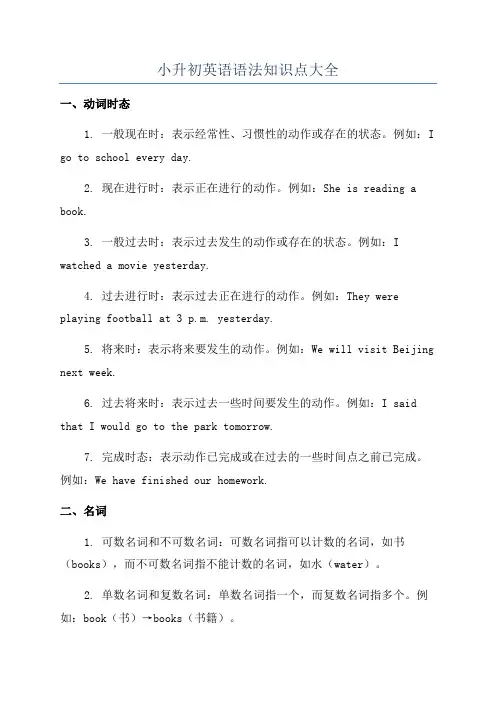
小升初英语语法知识点大全一、动词时态1. 一般现在时:表示经常性、习惯性的动作或存在的状态。
例如:I go to school every day.2. 现在进行时:表示正在进行的动作。
例如:She is reading a book.3. 一般过去时:表示过去发生的动作或存在的状态。
例如:I watched a movie yesterday.4. 过去进行时:表示过去正在进行的动作。
例如:They were playing football at 3 p.m. yesterday.5. 将来时:表示将来要发生的动作。
例如:We will visit Beijing next week.6. 过去将来时:表示过去一些时间要发生的动作。
例如:I said that I would go to the park tomorrow.7. 完成时态:表示动作已完成或在过去的一些时间点之前已完成。
例如:We have finished our homework.二、名词1. 可数名词和不可数名词:可数名词指可以计数的名词,如书(books),而不可数名词指不能计数的名词,如水(water)。
2. 单数名词和复数名词:单数名词指一个,而复数名词指多个。
例如:book(书)→books(书籍)。
3. 可数名词的复数形式:许多词在复数时需进行变位,如cat(猫)→cats(猫)、baby(婴儿)→babies(婴儿)。
4. 不可数名词的用法与数量表示:不可数名词无复数形式,不能与数词或a/an连用。
对于不可数名词表示的量,需使用量词或具体表示数量的词语,如a bottle of water、a cup of tea。
三、形容词和副词1. 形容词用法:形容词修饰名词,用来描述名词的性质或特征。
例如:a big dog(一只大狗)。
2. 形容词的比较级和最高级:形容词的比较级用于表示两个人或物之间的比较,如taller(更高),而最高级则用于表示三个或三个以上人或物之间的比较,如the tallest(最高的)。
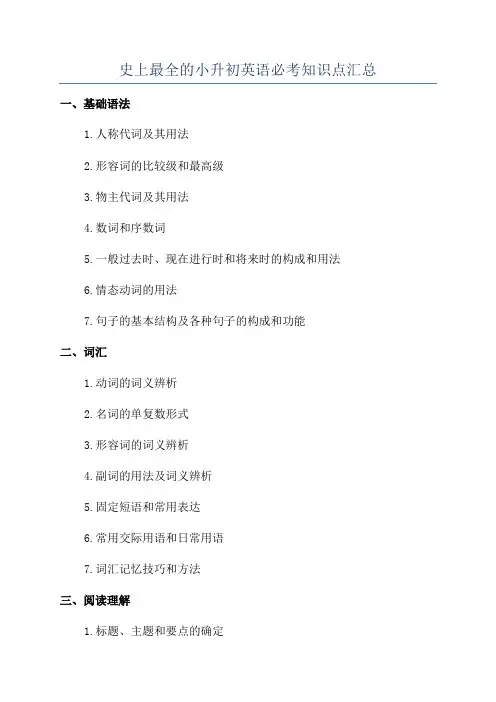
史上最全的小升初英语必考知识点汇总
一、基础语法
1.人称代词及其用法
2.形容词的比较级和最高级
3.物主代词及其用法
4.数词和序数词
5.一般过去时、现在进行时和将来时的构成和用法
6.情态动词的用法
7.句子的基本结构及各种句子的构成和功能
二、词汇
1.动词的词义辨析
2.名词的单复数形式
3.形容词的词义辨析
4.副词的用法及词义辨析
5.固定短语和常用表达
6.常用交际用语和日常用语
7.词汇记忆技巧和方法
三、阅读理解
1.标题、主题和要点的确定
2.速读和精读的技巧和方法
3.阅读技巧和策略
4.根据上下文理解生词
5.语法知识和词汇积累对阅读理解的帮助
6.能根据语境推测词义和句意
7.能够理解故事和文章的基本情节和主旨
四、写作
1.书面表达的格式和要求
2.逻辑思维和组织能力
3.简单句和复合句的写法
4.高频词汇和短语的运用
5.书写规范和语法正确性
6.表达自己的观点和观察力
7.提高写作水平的方法和技巧
五、听力
1.基本语音和语调
2.句子的语法结构和逻辑意义
3.句子的主题、中心和重点
4.通过听觉理解词意和句意
5.能够听懂对话和短文
6.能够根据听到的信息回答问题
7.提高听力技能的方法和技巧
这些知识点是小升初英语考试中必备的基础知识点,准备这些知识点对于顺利通过小升初英语考试有很大的帮助。
希望以上内容能对大家有所帮助,祝愿大家在小升初英语考试中取得优异的成绩!。
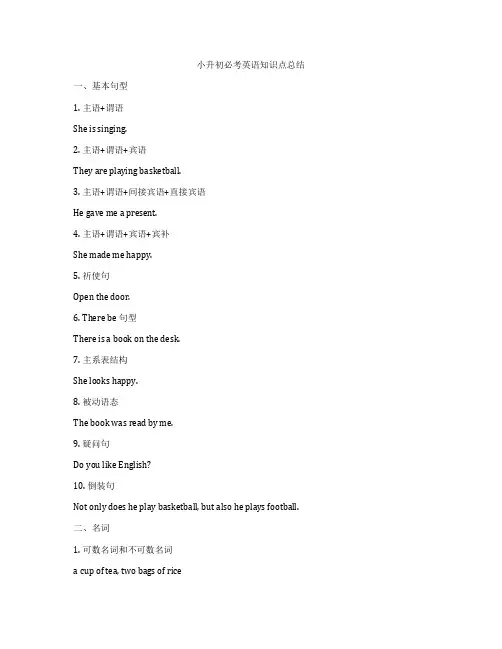
小升初必考英语知识点总结一、基本句型1. 主语+谓语She is singing.2. 主语+谓语+宾语They are playing basketball.3. 主语+谓语+间接宾语+直接宾语He gave me a present.4. 主语+谓语+宾语+宾补She made me happy.5. 祈使句Open the door.6. There be 句型There is a book on the desk.7. 主系表结构She looks happy.8. 被动语态The book was read by me.9. 疑问句Do you like English?10. 倒装句Not only does he play basketball, but also he plays football.二、名词1. 可数名词和不可数名词a cup of tea, two bags of rice2. 名词的所有格my father's car3. 名词的单复数a book, two books4. 特殊名词的复数形式child-children, woman-women5. 特殊名词的不可数名词形式news, information6. 特殊名词的复合名词形式forget-me-not, passer-by三、冠词1. 定冠词和不定冠词a book, the book2. 不加冠词的情况He is a student.3. 特殊用法once upon a time四、代词1. 人称代词I, you, he, she, it, we, they2. 物主代词my, your, his, her, its, our, their3. 反身代词myself, yourself, himself, herself, itself, ourselves, themselves 4. 特殊用法one another, each other五、动词1. 一般现在时He plays basketball every day.2. 一般过去时I played computer games yesterday.3. 一般将来时I will go to the park tomorrow.4. 现在进行时She is reading a book now.5. 过去进行时He was playing basketball at this time yesterday.6. 情态动词can, may, must, should, need7. 动词的不定式to do, to be8. 动词的-ing形式reading, playing9. 动词的完成时I have read that book.10. 动词的被动语态The book was read by me.11. 及物动词和不及物动词I like singing.六、形容词和副词1. 形容词的比较级和最高级big-bigger-biggest2. 副词的用法She sings well.3. 物主形容词my, your, his, her, its, our, their4. 特殊形容词和副词good-better-best, well-better-best七、介词1. in, on, at的用法in the classroom, on the desk, at home2. 特殊介词的用法under, over, between, among3. 介词短语in front of, next to, to the left of4. 介词词组on time, in time八、连词1. and, but, or的用法She likes playing basketball and football.2. because, so的用法He is tired because he works hard.3. 特殊连词的用法either...or, neither...nor, not only...but also...九、数词1. 基数词和序数词one, first2. 特殊数词的用法the first of October, one and a half 3. 特殊用法three times a week, two hours' time十、时间1. 日常时间的表达at seven o'clock, in the morning2. 一般现在时表示的未来情况I leave for Beijing tomorrow.3. 特殊时间状语的用法last Sunday, next Tuesday十一、情态动词1. can, may, must, shouldI can swim.2. 特殊情态动词的用法would like, need3. 特殊用法had better, have to十二、虚拟语气1. if引导的虚拟条件句If I were you, I would go now.2. wish引导的虚拟句I wish I were a bird.3. 特殊用法It's high time, If only十三、疑问句和感叹句1. 一般疑问句Do you like English?2. 特殊疑问句What's your name?3.感叹句What a nice day it is!四、定语和被定语1. 定语的位置和形式the red book, the book on the desk2. 被定语的位置和形式a city of the world, a boy with big eyes3. 特殊用法a cup of tea, the mother of all rivers 十五、主谓一致1. 就近原则Neither she nor I am good at singing.2. 特殊用法There be 句型十六、宾语从句1. 特殊宾语从句的引导词I know who the man is.2. 特殊宾语从句的时态I think he will come soon.十七、主语从句1. 特殊主语从句的引导词What you have said is true.2. 特殊主语从句的时态It's clear that they have won the game. 十八、定语从句1. 特殊定语从句的引导词The boy who is swimming is my friend.2. 特殊定语从句的时态I have lost the pen that you gave me.十九、状语从句1. 时间状语从句When the bell rang, we stopped working.2. 地点状语从句Where there is a will, there is a way.3. 原因状语从句Because he was ill, he didn't go to work.4. 条件状语从句If I were you, I would go now.5. 结果状语从句It's so late that we can't go out.六、语音1. 单词中元音的发音cake, team2. 单词中辅音的发音break, cream3. 单词重读音节的规律beautiful, comfortable4. 特殊音标的发音ai, ee, th七、词汇1. 同义词happy-glad, big-large2. 反义词happy-sad, big-small3. 同音词see-sea, for-four4. 词根act, behave5. 词缀happy-unhappy, Sunday-weekend 8、语法1. 句子成分的转换He doesn't like playing basketball. Playing basketball is not liked by him.2. 句子类型的转换She can swim. - Can she swim?十九、阅读1. 阅读理解阅读短文,回答问题。
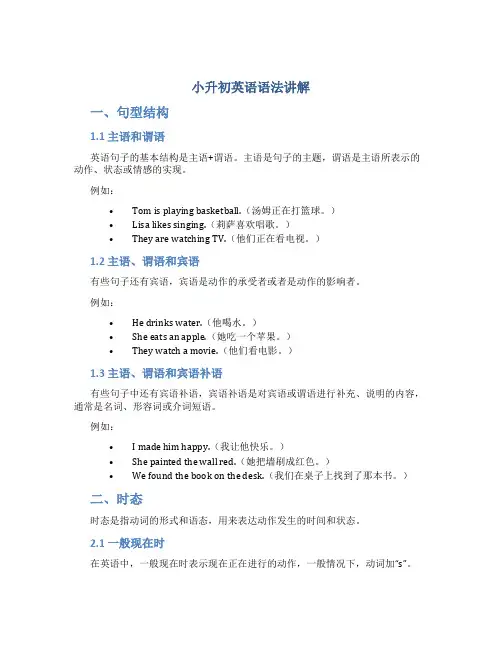
小升初英语语法讲解一、句型结构1.1 主语和谓语英语句子的基本结构是主语+谓语。
主语是句子的主题,谓语是主语所表示的动作、状态或情感的实现。
例如:•Tom is playing basketball.(汤姆正在打篮球。
)•Lisa likes singing.(莉萨喜欢唱歌。
)•They are watching TV.(他们正在看电视。
)1.2 主语、谓语和宾语有些句子还有宾语,宾语是动作的承受者或者是动作的影响者。
例如:•He drinks water.(他喝水。
)•She eats an apple.(她吃一个苹果。
)•They watch a movie.(他们看电影。
)1.3 主语、谓语和宾语补语有些句子中还有宾语补语,宾语补语是对宾语或谓语进行补充、说明的内容,通常是名词、形容词或介词短语。
例如:•I made him happy.(我让他快乐。
)•She painted the wall red.(她把墙刷成红色。
)•We found the book on the desk.(我们在桌子上找到了那本书。
)二、时态时态是指动词的形式和语态,用来表达动作发生的时间和状态。
2.1 一般现在时在英语中,一般现在时表示现在正在进行的动作,一般情况下,动词加“s”。
例如:•She gets up at 6:30 every morning.(她每天早上6:30起床。
)•He watches TV after dinner.(他晚饭后看电视。
)•They like playing basketball.(他们喜欢打篮球。
)2.2 现在进行时现在进行时表示现在正在进行的动作,时间状语一般是now。
例如:•They are playing basketball now.(他们现在正在打篮球。
)•She is writing a letter.(她正在写信。
)•I am studying English.(我正在学英语。
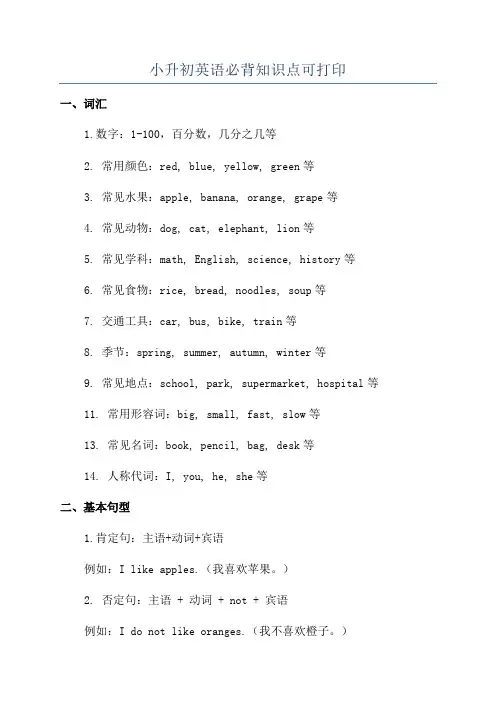
小升初英语必背知识点可打印一、词汇1.数字:1-100,百分数,几分之几等2. 常用颜色:red, blue, yellow, green等3. 常见水果:apple, banana, orange, grape等4. 常见动物:dog, cat, elephant, lion等5. 常见学科:math, English, science, history等6. 常见食物:rice, bread, noodles, soup等7. 交通工具:car, bus, bike, train等8. 季节:spring, summer, autumn, winter等9. 常见地点:school, park, supermarket, hospital等11. 常用形容词:big, small, fast, slow等13. 常见名词:book, pencil, bag, desk等14. 人称代词:I, you, he, she等二、基本句型1.肯定句:主语+动词+宾语例如:I like apples.(我喜欢苹果。
)2. 否定句:主语 + 动词 + not + 宾语例如:I do not like oranges.(我不喜欢橙子。
)3.疑问句:特殊疑问词+助动词/助动词+主语+动词+宾语例如:What do you like?(你喜欢什么?)4.一般疑问句:助动词/助动词+主语+动词+宾语例如:Do you like bananas?(你喜欢香蕉吗?)5. 答语:肯定回答:Yes, 主语 + 动词。
否定回答:No, 主语 + do/does not + 动词。
例如:Yes, I do. / No, I do not.三、时态1. 一般现在时:I/you/we/they + 动词原形,he/she/it + 动词原形 + s/es例如:I like to swim.(我喜欢游泳。
)2.一般过去时:主语+动词过去式例如:They played basketball yesterday.(他们昨天打篮球。
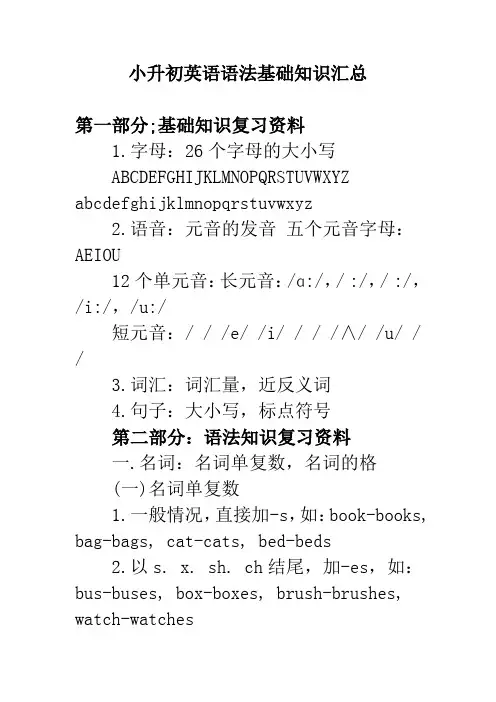
小升初英语语法基础知识汇总第一部分;基础知识复习资料1.字母:26个字母的大小写ABCDEFGHIJKLMNOPQRSTUVWXYZ abcdefghijklmnopqrstuvwxyz2.语音:元音的发音五个元音字母:AEIOU12个单元音:长元音:/ɑ:/,/ :/,/ :/,/i:/,/u:/短元音:/ / /e/ /i/ / / /∧/ /u/ / /3.词汇:词汇量,近反义词4.句子:大小写,标点符号第二部分:语法知识复习资料一.名词:名词单复数,名词的格(一)名词单复数1.一般情况,直接加-s,如:book-books, bag-bags, cat-cats, bed-beds2.以s. x. sh. ch结尾,加-es,如:bus-buses, box-boxes, brush-brushes, watch-watches3.以―辅音字母+y‖结尾,变y为i, 再加-es,如:family-families, strawberry-strawberries4.以―f或fe‖结尾,变f或fe为v, 再加-es,如:knife-knives5.不规则名词复数:man-men,woman-women,policeman-policemen,policewoman-policewomen,mouse-micechild-children,foot-feet,tooth-teeth,fish-fish,people-people,Chinese-Chinese,Japanese-Japanese不可数名词的复数就是原型: paper, juice, water, milk, rice, tea(二)名词的格1.有生命的东西的名词所有格:(1) 单数后加‘s 如: Lucy‘s ruler my father‘s shirt(2)以s 结尾的复数名词后加‘如: his friends‘ bags(3)不以s 结尾的复数后加‘s children‘s shoes并列名词中,如果把‘s加在最后一个名词后,表示共有;如:Tom and Mike‘s car 汤姆和迈克共有的小汽车表示所有物不是共有的,应分别在并列名词后加‘s.如:Tom‘s and Mike‘s cars 汤姆和麦克各自的小汽车2.表示无生命东西的名词通常用― of +名词‖来表示所有关系:如:a picture of the classroom a map of China二.冠词:不定冠词,定冠词种类:(一) 不定冠词:a / an元音读音开头的可数名词前用an :an egg / an apple / an orange / an eraser / an answer / an ID card / an alarm clock / an actor / an actress / an e-mail / an address / an event / an example / an opera / an hour an old man / an interesting book / an exciting sport / an action movie / an art lesson /(二)定冠词:the定冠词的用法:1.特指某(些)人或某(些)物: The ruler is on the desk.2.复述上文提到的人或物:He has a sweater. The sweater is new.3.谈话双方都知道的人或物:The boys aren‘t at school.4.在序数词前: John‘s birthday is February the second.5.用于固定词组中: in the morning / afternoon / evening 不用冠词的情况:(1)专有名词前:China is a big country.(2)名词前有定语:this , that , my , your , some, any , no 等:This is my baseball.(3)复数名词表示一类人和事:Monkeys can‘t swim. They are teachers.(4)在节日,日期,月份,季节前:Today is Christmas Day. It‘s Sunday.(5)一日三餐前:We have breakfast at 6:30.(6)球类棋类运动前:They often play football after class. He plays chess at home. * 但乐器前要用定冠词:I play the guitar very well.(7)学科名称前:My favorite subject is music.(8)在称呼或头衔的名词前:This is Mr Li.(9)固定词组中:at noon at night by bus三、形容词,副词:比较级,最高级(一)、形容词的比较级1、形容词比较级在句子中的运用:两个事物或人的比较用比较级,比较级后面一般带有单词than。
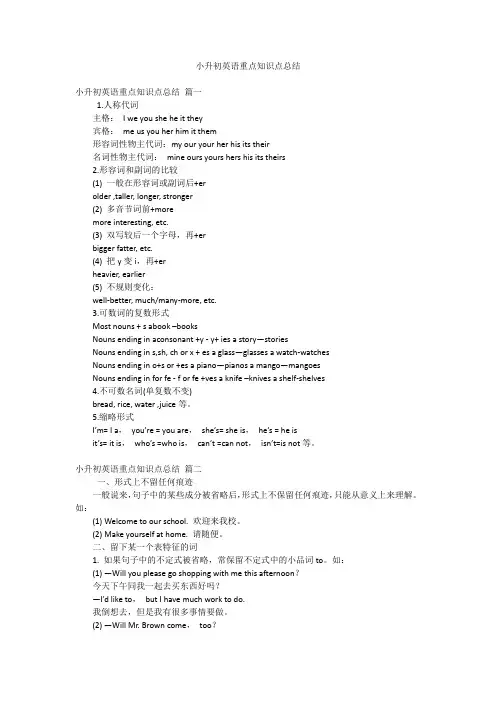
小升初英语重点知识点总结小升初英语重点知识点总结篇一1.人称代词主格:I we you she he it they宾格:me us you her him it them形容词性物主代词:my our your her his its their名词性物主代词:mine ours yours hers his its theirs2.形容词和副词的比较(1) 一般在形容词或副词后+erolder ,taller, longer, stronger(2) 多音节词前+moremore interesting, etc.(3) 双写较后一个字母,再+erbigger fatter, etc.(4) 把y变i,再+erheavier, earlier(5) 不规则变化:well-better, much/many-more, etc.3.可数词的复数形式Most nouns + s abook –booksNouns ending in aconsonant +y - y+ ies a story—storiesNouns ending in s,sh, ch or x + es a glass—glasses a watch-watchesNouns ending in o+s or +es a piano—pianos a mango—mangoesNouns ending in for fe - f or fe +ves a knife –knives a shelf-shelves4.不可数名词(单复数不变)bread, rice, water ,juice等。
5.缩略形式I’m= I a,you’re = you are,she’s= she is,he’s = he isit’s= it is,who’s =who is,can’t =can not,isn’t=is not等。
小升初英语重点知识点总结篇二一、形式上不留任何痕迹一般说来,句子中的某些成分被省略后,形式上不保留任何痕迹,只能从意义上来理解。
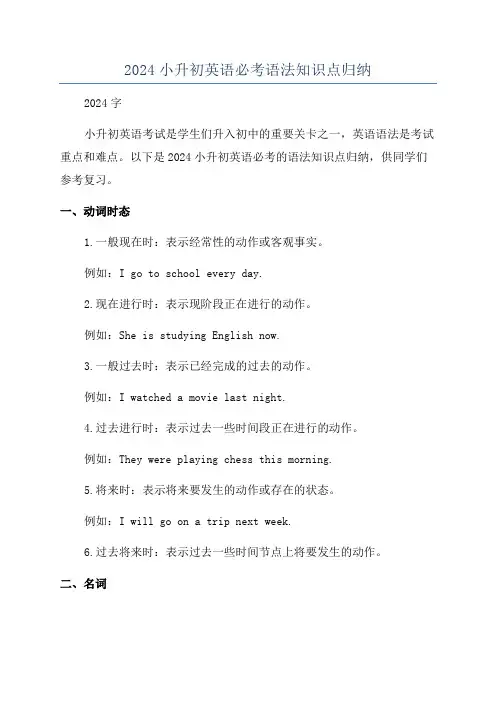
2024小升初英语必考语法知识点归纳2024字小升初英语考试是学生们升入初中的重要关卡之一,英语语法是考试重点和难点。
以下是2024小升初英语必考的语法知识点归纳,供同学们参考复习。
一、动词时态1.一般现在时:表示经常性的动作或客观事实。
例如:I go to school every day.2.现在进行时:表示现阶段正在进行的动作。
例如:She is studying English now.3.一般过去时:表示已经完成的过去的动作。
例如:I watched a movie last night.4.过去进行时:表示过去一些时间段正在进行的动作。
例如:They were playing chess this morning.5.将来时:表示将来要发生的动作或存在的状态。
例如:I will go on a trip next week.6.过去将来时:表示过去一些时间节点上将要发生的动作。
二、名词1.可数名词与不可数名词:可数名词有单数和复数之分,不可数名词只有单数形式。
例如:table(可数), water(不可数)2.名词所有格:表示所有关系时,在名词后加's。
例如:Tom's book(汤姆的书)3.复合名词:由两个或两个以上名词构成并有一定结构的名词。
例如:classroom, basketball三、形容词与副词1.形容词用来修饰名词,副词用来修饰动词、形容词或其他副词。
例如:She is a beautiful girl.(形容词修饰名词)He runs fast.(副词修饰动词)2. 形容词的比较级和最高级:一般在形容词后面加-er表示比较级,在形容词前面加the最高级。
例如:He is taller than me.(比较级)He is the tallest boy in our class.(最高级)四、代词1. 人称代词:主格形式有I, you, he, she, it, we, they;宾格形式有me, you, him, her, it, us, them。
小升初英语总复习一一词汇句型语法词汇篇三年级到六年级词汇I* 邹习用品[school things)pen钢笔perbctl蛰笔pencil粉笔盒ruler尺子book书b昭包comic Lig・h 潼鱼书potl ^aiJ 明侑才ucwspupei 报schoolbag 书包.ctabct 常皮tB-iyuii 蜡越^har|x?ner skuy IxwA 战尝书nowboQk 笔j己本Chineset>boLt§文书En妙pb b&olc英[曾书math boetk数学朽nm喪毗ine杂志iilciionary 词典二、人依(body)fact hend face hsiir■头寂oose fk子rncmh 圏eye ear K朵Mn手聲hand手fin声[■手指畑"尾巴三、颜邑(colours)icd blue y-ellow tf: given 嫌while 白black pink tfrZT purple V oningc ® thrown 棕皆 * 动输(anivnals)百at 烧Jog ;'j pig 猪曲wk 邛rabbit 兔horse 马elepti3.nl 尢象anl fish birci 溥eagl-e buaver 海與snake 蛇ruous^ 老鼠squirrel kii咚金rw?撻鬣monkvy 5^ panda 忘町舉li知訂卯子liger 湮顕>弗斑马deer® giiafft长颈鹿gg紀晤h亡it母鸡cudKy火誨恤mb小羊卜hgp绵羊炉泌』羊gw奶牛donkey 円1血就田lol>£ter龙45 s-lMrkX 鱼scnl 晦荊spemi whale kilEer whale五,人粉(people)friend l\^\ boy 男按gid 女拽mot tier 加1忙「乂亲sister brother 兄第mnclc叔找;;翼舅niaii k.咖man女人Mr先生Miss小蛆lady女 +:小克U iTioni dad忡3皿& =母giandnia / grandnKither ( ^-1 坷理arandpa grandfather (夕卜》祖辺nuiit SffiJS w呦堂(頁)兄第占堂[卷)姐竦$<>ft儿子baby 儿kid小孩心心紳ru畑同率:queen女壬visitor春观者:ieiuhbc*ur °內心卩;吐枝丘imiveniity student 生pen paJ 耳友touiisl旅行者people人物ivbvr机器人六.职业(jobs)teacher 教师stuiJerit 学生doctor 生nurse 护士driver a]{fl farmer 农民singer}i;PS家writer 作家actoi男演员actress女演员ailist画家TV reporter 电视台■记者engineer工程师ac-countant 计policeman (男)警察salesperson 售员cleaner清洁工baseball player璨球运动员assistant^货员policeman 警察七.金品、饮称(food&drink)rice米饭bread面包beef牛闵niilk牛奶water水egg蛋fish鱼tofu豆膺cake 蛋槿hot dog 热徇hamburger汉堡•包French fries 炸5?录cookie 曲奇biscuit饼干jam果酱noodles面奈meat 闵chicken鸡肉pork猪离niiitton羊肉vegetable蔬奖salad沙拉soup汤ic亡冰icecream 冰淇淋Coke 叮乐juice 卑汁tea 杀coffee ij]啡breakfast lunch "二養dinner晩寒八.就菜(fruit & ^egjeiables)apple 果banana香焦peai•梨orange watermelon 西瓜grapecggplanl 茄子arc<n beans W12 loiuato S红柿polalo 土卫丄peach strawberry 草IS cucumber 黄瓜onion 洋麴carrot 胡夢卜cabbage 心菜九.衣服(clothes)jacket夬克衫shirt时衫T shirt Tflfil杉skirt短如子divssj^衣裙jcan$牛仔脾ponZ长嚮goc4 袜子yhoe^^,子sweater 毛农coat -HdfC raincoat 农shorts SStW &ncak<re 网球鞋dip严n?扌总鞋sandals 凉鞋boots 就子hat (有沿的)帽子cap便垢siMiglasjtes太阳粛论领带scarf ®rftgloves手奈十、交適工具(vehicles)bike自行:车bn*公共汽车〔rain夬车boat小船whip轮船yacht快艇car小汽车tax】岀租车jeup吉普车Zu小货车;画包车plane飞机subway地铁motor cycle 摩托车十一■杂杓(other things)window 户door I -] desk chair 椅子be<i 床computei•计算机board号字柢fan 凤房light 灯teacher s dcs-k picture P,K 片wallflooi•地板curtain 窗帘trash bin 垃圾箱closet §5 ^ mirror镜子end tabl«床头柜foo<ball足球present木X毎walkman边身听lamp台灯phone电话sof温抄发shelf 书桀fridg亡冰箱table 卓子T*V 电air-conditioner ^*1^1 key钢匙lock photo戈理片chart图表plate 盘子knife 刀foTk 叉spoon 勺子chopsticks^ 子pot^ gift 才UltjJ loy 玩具doll 洋娃妇f ball 球balloon 气球kite风羊jigsaw puzzle拱图诉戏box銓子umbrella伞jdpper拉縫violin小提琴yo-yo瀏窗球riesi鸟窝hole洞tube诗子toothbrush牙吊I menu菜单e-card电子卡片e-mail电子邮件traffic light交通灯money钱medicine 药十二.地点(locations)heme:芻room .房国bedroom 卧室Kathrcdm 卫生间living room 超居主kkchen强J呀classgom教室school学^校pnrk公园libraryO书馆* post office 由石岗hospital医腕cinema电影腕bookstore书店farm 衣场zoo 动物园^ardea 花园study 书房pgygrouiiJ 操境canteenteacher's office 教U巾刃•公宅library图书馆gym 育馆washroom卫生间art room绘画教室coiikputcr room 计算机致室music room 音乐敦室TV room 电观机冈门皿公寓company ^-SJ facioty 工J_ fmit st^nd 水果摊pel shop 走物商店nature park 自然公园thenz pa*主題公园science nniseufri科学恃旃店the Great Wall 览城supermarket 超市Zink 银厅country*' 家sullage 乡村cily 城市十三.课4? (classes)spans 体耳运动science 联学Moral Educaliori.^-A^.nn® Serial Studies社会课十四.国家.城市(countries; & cities)China f PRC 中国America f USA 美国UK 联合王国England 英国Canada / CAN 1K:拿大/Xustralia 澳大利亚New York 纽约London ft;St Sydney 尼Moscow莫斯科Cairo开罗十五.毛象(weadier)cold赛冷的 warm 的cool涼典的snowy下雪的sunny晴明的ho〔炎热的rainy卜雨的windy 有风的cloudy多云的weather report天气预报十六.景扌分(naillne}river河流lake湖泊m河:溪fore&i森林path小道road公路hous 房子bridge^ building^ 筑物rain 雨cloud 云口山太阳mountain ill &ky 天空rainbow彩41 wind风air空气十匕.竝杓(plants>flower 花gras^ 草tree 村t 种于sprout 苗plant 植书J rox 玫瑰leaf叶子十丿、•空期(week)Monday 星期—Tuesday 屋期二Wednesday 星據三Thursday 星期四Friday 星期冇SaturdaySunday Ai* H weekend 喝末十九.JI 紛(months>Jan.(January >—月Feb.(Febmary> Z1 月Mar.(March)三月April 四月May 五月Jun© 六月July 七月August) 八戸Sept. (September)月Oct.(October) 十月Nov. (Novenibcr) -| ----------------- 月I>ec.( December) 十二月二十.审节(seasons>spring 春summer J£ fall 秋winter二十一.方隹〈directions)south 南north 北east 东west 西left 左right 右边二十二•烹炳(illness)liav^p a fev^r 友烧huix 疼痛hav^ a coLJ 感官iiav$? a loot lia^h< 牙疼liav«? a headache 头珂have a sote throat d锲味疼二屮■三.亍司(munbers)one 一two 二three 三four 四fiv«五six 六seven 七eight 八nine 九ten 十eleven ~| twelve 十二thirteen 十三fourteen 十四fifteen 十五sixteen seventeen 十七eighteen4"/k nmeteen-p/L twenty 二十iliirty 三十forty 四十fifty 五•卜s.ixty 六seventy 七十eighty丿'十ninety 九十hundreds fiel捣一secondUiird第三fourth^四fifth eighth^A ninth 第九twelfth 第十二twentieth 第二十二十B.形容対big大的siiiall小的knig长的lail高的short短的&矮的young密轻的old 旧的.老的strong 壮的thin «g的active积极活蹶的quiet安静的nice 好看的kmd和磚亲切的suict■严•格的sinait^-明的funny出稽可笑的tasly 好吃的sweet舌甘的salty成的sour険的fresh祸鮮的favourite最喜爱的clean干净的tired ^35的excited兴奋的angiy生气的happy高兴的bored 无聊的szei忧愁的taller車商的shorter 的 stronger更強壮的oldc「年龄更大的younger更佯轻的bigger史大的heavier更重的longer更长的thinner更瘦的smaller更小的good好的fine好的great很好的heavy S的new的fat胖的happy快乐的right对的hungry 饥饿的cule汩人喜彖的liltlc 小的Lovely BJ® 的Zautiful漂亮的coburful色形鲜艳的prctlyj^^的c!wap便宜的expensive 贵的juicy 多汁的tender^:的hmlthy 箸康的ill 有痴的helpfuI有帮助的high髙的easy简单的proud骄做的sick有蜩的better更好白勺higher更髙的二十jtiL.介词(prep.)in在..... 里on柱..... Jb«在...... 时候under在........ 下面near?£................. 的旁边behind在 ..... 后边next to与..... 相邻over•在...... 上面in front of在 -------- 爾面二十六.代词(proti.)I我we我们you你.你们he他she她M它they他(她.它Hf] my我的our我们的your你的.你们的his他的her她的二十七、劝诃(V,)play 玩.踢swim 游泳slug 滑冰fly 飞jump 跳walk 走mn climb 爬fight打架swing cat吃sleep 腫觉Hkc像.矣欢hog 有$吃turn转弯buy买Wke买*带live居住teach go去study半习lcam 半可sing唱程上dance跳舞row 划do homework做作业watch XY 看电视read hooks 谀书cook the meals 做饭w;n<s「the flowers 浇花sweep rhe floor fl地clean the bedroom 打扫野空make the bed 4ftsei the table 摆饭康wash the clot lies 洗衣月艮do the dishes 洗碗速ux a coinpiitci 便用汁算机do morning exercises 復练:彳枝广扌帝慢breakfast 吃早饭cut dinner 饭go to school上学have English cla&sJx^语课phy sporls迸行偉育运动驴I up起床cliinb iiKniiLiains.^山琴0 shopping 买牢西|>lay ilic piano^4?^ •*? visit ^niiulpdreiits^ 祟(外)相父母go hiking去远足fly kites放凤羊make a snowman堆寺人plant 1皿<!£种£对draw picturescook dimitf rivad a book 若书answer ihc phone 接电话lisien to inu^ic 听音乐ckan【he room 打捋房间wriie a lciwr 写信 write an e-mail 写电子邮件dnnk water take pictures 照相watchinsccls 娩黍足虫pick up leaves 采摘树叶do an cKpcrimcnl 做实验catch Lniitcrflic®.抿蝴媒count insects 散昆虫collect insects 收英昆虫collect leaves 收杲树叶write a report 写报告play chess F棋have a picnic 举行野餐gel io 到达ride a bike唸自厅车play the讥」1讪如嗖琴make kites制作风華collect stamps英邮meet 面welcome迎thank谢谢love 爱work X作drink 喝taste尝smell 闻Feed 喂养shear勞nulk挤奶look ft guess猜help帮勛pH删传連show ;K u諾佚用cS口打押ope”打产匚山鈕关上|'ut 放也列读wiite^ paitU绘画心11告诉kiwk踢boung反强rig琦材呻停wii it 筹find 找drive EG fold #f &en<t 寄wofsh 诜stine ^SS become变成fed ihinlc思考遇见fall藩下le・ve离开wake叶舉来put OK穿上也k^uff雀捽帕挂起we報穿gohonie回家go 旳bed上床陌堂pby cMFUt住T^axne#玩电脑游戏佩ayctress下模do housework 做寒务empty ihc 1ra.xhS'teJ5 puE away lhe clothe sJt拾衣腹get offT^ c.ik)c a irip 去旅= ztd a iiidgazuw 闻淒杂吉go lo the C JILCIIM夫音电券六年级英语总复习-词语归类、写出完全形式1. w h o' s who is2. she's she is3. he's he is4. w hat's what is5. where's where is6. we'r e we are7. yo u' re yo u are8. that's that is9. I'm I am 10. i sn't is not 11. are n't are not 12. they'r e they are13. don't do not 14.1 et's let us 15. can ' can not 16. it's it is17. I ' ve have 18. I ' d would 19. hasn ' has not二、写出下列单词的复数形式。
小升初英语重点短语句型语法一、重点短语library 图书馆post office 邮局hospital 医院cinema 电影院bookstore 书店science museum 科学博物馆turn left 向左转turn right 向右转go straight 直行north 北south 南east 东west 西next to 靠近、与……相邻then 然后二、重点句型1.Where is the cinema, please? 请问电影院在哪里?2.It’s next to the hospital.它与医院相邻。
3.Turn left at the cinema, then go straight.It’s on the left.在电影院向左转,然后直行。
它在左边。
重点语法1.问路时要用"excuse me 对不起,打扰一下"2.描述路时可以用顺序词:first首先,next接着,then然后3.near 表示在附近,next to 表示与…相邻,它的范围比near小。
in front of 在。
前面 behind 在……后面4.在左边,在右边介词要用on, on the left/on the right,但是东西南北,介词要用in,in the north/east/south/west.5.for 表示持续多长时间,当表示做某事多长时间都要用for.如:Walk east for 5 minutes.Then walk straight for three minutes.6.乘几路车可以用by the No.301 bus,注意No.中N要大写,后面要加点。
如果要用动词可以用take,例如take the No.301 bus.7.当表示某个地方在另一个地方的哪一方向时,要用介词of。
如:the hospital is east of the cinema.医院在电影院的东边。
小升初英语复习指南--英语词汇一、小升初英语固定搭配短语汇总小升初英语复习中,有许多的重点,包括单词,时态,语法,短语等等!今天,本教师就收集了一些小升初英语的固定短语,汇总在一起供大家查看,希望对大家有所帮助!1.allow sb to do sth允许某人去做某事(后接动词不定式)My father allowed me to go out for a walk after finishing my homework.2. asked sb (not) to do sth叫某人做事某事(叫某人不要去做某事)My father asked me to study hard.He asked me not to swim alone.3.be asked to do sth被叫去做某事/被邀请去做某事I was asked to have a dinner with them yesterday.4. be afraid to do sth害怕做某事She is afraid to ask me questions.5. be afaid of doing sth害怕做某事I am afraid of going out at night.6. be afaid of sth害怕某物He is afraid of snakes.7. be amazed to do sth对做某事感到惊讶He was amazed to meet the girl there.8.be amazed at sth对某事感到惊讶they were amazed at the news.9. be busy doing/with sth忙于做某事(常考)I was busy washing my car at that time. 那时候我正忙于清洗我的车I am busy with my work.8. be coming/going/leaving/fiying/moving/dying(某些位移动词用进行时态时表将来)the bus is coming/the dog is dying.9. be excited to do sth对做……感到兴奋Jacky was excited to travel there by plane.be excited at sthLily was excited at his words.be excited about doing sthhe was excited about passing the exam without going overing books.10. be frightened to do sth害怕去做某事Sam is frightened to ride a horse.11. be glad/happy to do sth高兴去做某事she is happy to clean the blackboard with me.be pleased to do sth高兴做某事she was pleased to help the old man yesterday.be pleased with sth对某事感到高兴/满意the teacher was pleased with my answer.12.be interested in sth/doing sth对某事感兴趣/对做某事感兴趣she is interested in swimming in the river.My btother is interested in Chinese.13.be/get ready for/to do sthBe ready for sth为某事做好了准备We are ready for the exam.Be ready to do sth为做某事做好了准备We are ready to have a birthday party for her.get ready for sth为某事在做准备We are getting ready for the exam.get ready for sth为做某事而做准备13. be sorry to do sth对做某事感到抱歉14.be surprised to do sth对做某事感到惊奇be surprised at sth 对某事感到惊奇15. be worth doing sth值得做某事(worth 后接动词-ing形式,常考)16. 开始去做某事begin to do sthbegin/start to do/doing sth17. can/be able to afford (to buy) sth 有能力购买(供)……18. can/may/must do sth could/would/should/might do sth19. can’t wait to do sth 迫不急待地去做某事20. decide to do sth 决定去做某事make up one’s mind to do sth 下决心去做某事(常考)make a decision to do sth 对做某事作出决定21. deserve to do sth 值得/应该做……22. encourage sb to do sth 鼓励某人去做某事23. enjoy doing sth 乐意去做某事24. expect (sb) to do sth 期望去做某事25. fail to do sth 做某事失败succeed doing sth 成功做了某事26. finish doing sth 做完某事(后接动词-ing形式)(常考)27. follow sb to do sth 跟随某人去做某事28. 让某人做某事(后接动词原形)get sb to do sthmake sb do sthlet sb do sth29. get/have a chance to do sth 得到一个做某事的机会30. give/pass/show/lend/sell sb sth/sth to sbbuy/get/bring sb sth/sth for sb31. go on to do sth 继续做事(常考)go on doing sth 继续做事(常考)32. hate to do/doing sth 讨厌/不喜欢做某事33. have fun doing sth34. have problems doing sth 做某事遇到困难35. 让某人做某事(后接动词原形)have sb do sthhave sth donehave sth to do 工有事要做36. hear sb do sth 听到某人做某事(后接动词原形,常考)hear sb doing sth 听到某人正在做某事(常见)37. help to do sth 帮忙做某事help sb (to) do sth 帮助某人做某事38. hope/wish to do sth 希望做某事wish sb to do sth 希望某人做某事39. I t seems that 这像是……(后接从句)seem to do sthseem +adj40. It’s + adj+(for sb) to do sth .It’s+adj +(of sb) to do sthIt’s glad for him to hear the news.41. It takes sb some time/money to do sth . 花费某人多长时间做某事42. pay …for… cost spend…on….. it take …to do sth43. It’s best for sb to do sth. 对某人来说做某事是最好的had better do sth 最好做某事(注意had没有时态和人称的变化,better后接动词原形)44. It’s time for sb to do sth 是某人做某事的时候了45. keep (on)doing sth 坚持做某事(常考)keep sb doing sth 让某人做某事(常考)keep sb from doing sth 阻止某人做某事(常考)keep sb/sth +adjkeep the book for 2 days 借这本书两天(不要用borrow或lend)46. learn to do sth 学做某事learn sth from sb 向某人学习47. like to do/doing sth 喜欢做某事like sb to do sth 喜欢某人做某事48. need to do sth 需要做某事need doing sth/to be doneneed sth needn’t do sth49. prefer to do sth rather than do sth 宁愿……而不愿……(常考)prefer doing sth to doing sth 喜欢做……胜过做……I prefer reading books to going shopping. 比起购物来,我更爱读书。
小升初所有英语知识点总结
一、基本语法
1. 词类:名词、代词、形容词、副词、动词、介词、连词、数词等。
2. 句型:陈述句、疑问句、祈使句、感叹句等。
3. 时态:现在时、过去时、将来时、现在进行时、过去进行时、一般将来时等。
4. 语态:主动语态和被动语态。
5. 语气:陈述语气、疑问语气、祈使语气。
二、词汇
1. 单词拼写:包括常用单词的拼写和使用。
2. 词组和短语:表示时间、地点、方向、数量、比较等的常用词组和短语。
3. 同义词和反义词:常用的同义词和反义词的使用。
三、阅读理解
1. 阅读能力:理解短文的主题、大意和细节,抓住关键词语。
2. 阅读技巧:如猜测词义、推断意思、理解语境等。
四、写作技巧
1. 书写规范:包括字母书写、大小写、标点符号等。
2. 句子结构:句子的基本结构、句型转换等。
3. 作文写作:如图画作文、看图写话、日记、书信、应用文等。
五、口语表达
1. 日常交际用语
2. 基本口语句型
3. 听力训练
六、语音语调
1. 单词音标
2. 语音规律
3. 语调模仿
以上是小升初英语考试的基本知识点总结,希望对您有所帮助。
小升初英语语法复习要点一、名词复数规则1.一般情况下,直接加-s,如:book-books, bag-bags, cat-cats, bed-beds 2.以s、x、sh、ch结尾,加-es,如:bus-buses, box-boxes, brush-brushes, watch-watches3.以“辅音字母+y”结尾,变y为i, 再加-es,如:family-families, strawberry-strawberries4.以“f或fe”结尾,变f或fe为v, 再加-es,如:knife-knives 5.不规则名词复数: man-men, woman-women, policeman-policemen, policewoman-policewomen, mouse-mice child-children foot-feet,.tooth-teeth fish-fish, people-people, Chinese-Chinese, Japanese-Japanese二、一般现在时1.一般现在时表示经常或习惯性的动作,也可表示现在的状态或主语具备的性格和能力。
2.一般现在时中,没有be动词和情态动词,主语为第三人称单数的肯定句,动词要按规则加上s,主语是非第三人称单数的肯定句,动词用原形。
3.在一般现在时中,句中有be动词或情态动词时,否定句在be动词和情态动词后加not,一般疑问句将be动词或情态动词放在句首。
4.在一般现在时中,句中没有be动词或情态动词时,主语为第三人称单数的否定句在动词前加does+not (doesn’t),一般疑问句在句首加does,句子中原有动词用原形;主语为非第三人称单数,否定句用do+not (don’t),一般疑问句在句首加do,句子中动词用原形。
动词+s的变化规则1.一般情况下,直接加-s,如:cook-cooks, milk-milks2 .以s. x. sh. ch. o结尾,加-es,如:guess-guesses, wash-washes, watch-watches, go-goes3.以“辅音字母+y”结尾,变y为i, 再加-es,如:study-studies三、现在进行时1.现在进行时表示现在正在进行或发生的动作,也可表示当前一段时间内的活动或现阶段正在进行的动作。
最新人教版小升初英语必考知识点总结最新人教版小升初英语必考知识点总结一、动词时态1、一般现在时:主语+动词原形+其他;表示习惯性、经常性的动作或状态。
例:I usually get up at 7 o'clock every morning.2、现在进行时:主语+be+动词ing+其他;表示正在进行的动作或状态。
例:He is playing basketball now.3、一般将来时:主语+will+动词原形+其他;表示将来要发生的动作或状态。
例:She will visit her grandparents next weekend.二、名词1、单数名词:指只有一个单词的名词,如cat, dog等。
2、复数名词:指有两个或以上单词组成的名词,如cats, dogs等。
三、冠词1、不定冠词a/an:用于可数名词单数前,表示泛指或数量“一”。
例:There is an orange on the table.2、定冠词the:用于可数名词复数前,表示特指或上文提到的某个事物。
例:The cats are playing in the garden.四、代词1、人称代词:指用来代替人的代词,如I, you, he等。
2、物主代词:指用来表示物品所属关系的代词,如my, your, his 等。
五、形容词和副词1、形容词:用来修饰名词,表示名词的性质或状态,如beautiful, happy等。
2、副词:用来修饰动词、形容词或其他副词,表示动作的方式或程度,如quickly, carefully等。
六、介词1、表示时间的介词:in表示在某个时间范围之内,on表示在某一天或具体某一天的上午或下午,at表示在某一具体时间点。
例:I will arrive at the airport at 10 o'clock.2、表示地点的介词:in表示在某个地方范围之内,on表示在某物表面上,at表示在某个具体地点。
小升初英语总复习——词汇句型语法词汇篇三年级到六年级词汇六年级英语总复习-词语归类一、写出完全形式。
1.w h o's2.s h e's3.h e's4.w h a t's5.w h e r e’s6.w e'r e7.y o u'r e8.t h a t's9.I'm10.i s n't11.a r e n't12.t h e y'r e 13.don't 14.let's 15. can’t16. it's17. I’ve18. I’d19. hasn’t二、写出下列单词的复数形式。
1.b u s2.b o x3.g l a s s4.c l a s s5.w a t c h6.m a n g o7.f i r e f l y8.s h e e p9.p e o p l e10.m a n11.w o m a n12.a p p l e 13.f a m i l y14.l i b r a r y15.b a b y16.b o y 17.toy 18.child 19.foot 20.strawberry21.horse 22.policeman 23.dress 24. fish25.tooth 26.country 27. foot 28.dragonfly29.me 30.building 31. cloth 32. this33. that 34.circle 35.story三、反义词或对应词。
1.s a m e2.n e w3.o l d4.s h o r t5.b i g6.t a l l7.y e s8.o p e n9.h o t10.h e r e11.s i t12.u p13.t h i n14.f a t h e r15.r i g h t16.b l a c k 17.t h i s18.t h e s e19.b o y20.g r a n d f a t h e r 21.m a n22.h u s b a n d23.a u n t24.b r o t h e r 25. he 26. left 27. go 28. nurse29. good bad 30. minus plus 31. his her 32. busy free33. hand foot 34. legs arms四、近义词。
1.desk table2. like love3. often usually4. start begin5. great good五、同音词。
1.t o t o o、t w o2.r i g h t w r i t e3.n o k n o w4.f o r f o u r5.h e a r h e r e6.I e y e7.s e e(C)s e a8.s o n s u n9.b e(B)b e e10.t h e r e t h e i r11.U y o u12.Y w h y 13. by buy 、bye 14. pair pear 15. R are 16. whose who’s17. aunt aren’t六、现在分词。
1. swim ( 现在分词)2. come( 现在分词)3. dance (-ing形式)4. ski (-ing形式)5. sit (-ing形式)6. fly (-ing形式)7. stay (-ing形式) 8. travel (-ing形式)9. cry (-ing形式) 10. play (-ing形式)11. listen (-ing形式) 12. collect (-ing形式)13. make (-ing形式) 14. take (-ing形式)15. write (-ing形式) 16. read(-ing形式)17. clean (-ing形式) 18. sing (-ing形式)19. sweep (-ing形式) 20. run (-ing形式)七、综合。
1. study (第三人称单数)2. students(名词所有格)3. sister(名词所有格4. two(序数词)5. have(第三人称单数)6. cat (名词所有格)7. Tom(名词所有格) 8.teacher(动词)9. cry(第三人称单数) 10.Nancy(名词所有格)11. can(否定式) 12. good(比较级)13.catch(第三人称单数) 14. wash (第三人称单数)15. quickly(形容词) 16. visit(名词)17. China(形容词) 18. French(名词)19. quiet(副词) 20. one(序数词)21. cook(第三人称单数) 22. do(第三人称单数)23. beautifully(形容词) 24. many (比较级)25. Australian(名词) 26. brush(第三人称单数)27. work(名词)八、人称代词。
1. I (宾格)2.you(宾格)3. he (宾格)4. she(宾格)5. I(复数)6. you (复数)7. he/she/it (复数)8. we(宾格) 9. you(宾格) 10. they (宾格)11. I (形容词性物主代词) 12. you(形容词性物主代词)13. he (形容词性物主代词) 14. she (形容词性物主代词)15. they (形容词性物主代词) 16.I(名词性物主代词)17. you (名词性物主代词) 18. he (名词性物主代词)19. she (名词性物主代词) 20. we(名词性物主代词)21. you(名词性物主代词) 22. they(名词性物主代词)语法篇小学英语语法及习题一、名词复数规则1.一般情况下,直接加-s,如:book-books, bag-bags, cat-cats, bed-beds2.以s. x. sh. ch结尾,加-es,如:bus-buses, box-boxes, brush-brushes, watch-watches3.以“辅音字母+y”结尾,变y为i, 再加-es,如:family-families, strawberry-strawberries4.以“f或fe”结尾,变f或fe为v, 再加-es,如:knife-knives5.不规则名词复数:man-men, woman-women, policeman-policemen, policewoman-policewomen, mouse-micechild-childrenfoot-feet,.tooth-teethfish-fish, people-people, Chinese-Chinese, Japanese-Japanese写出下列各词的复数I _________him _________this ___________her ______watch _______child _______photo ________diary ______day________ foot________ book_______ dress ________tooth_______ sheep ______box_______ strawberry _____thief _______yo-yo ______ peach______ sandwich ______man______ woman_______ paper_______ juice___________water________ milk________ rice__________ tea__________二、一般现在时一般现在时基本用法介绍【No. 1】一般现在时的功能1.表示事物或人物的特征、状态。
如:The sky is blue.天空是蓝色的。
2.表示经常性或习惯性的动作。
如:I get up at six every day.我每天六点起床。
3.表示客观现实。
如:The earth goes around the sun.地球绕着太阳转。
一般现在时的构成1. be动词:主语+be(am,is,are)+其它。
如:I am a boy.我是一个男孩。
2.行为动词:主语+行为动词(+其它)。
如:We study English.我们学习英语。
当主语为第三人称单数(he, she,it)时,要在动词后加"-s"或"-es"。
如:Mary likes Chinese.玛丽喜欢汉语。
一般现在时的变化1. be动词的变化。
否定句:主语+ be + not +其它。
如:He is not a worker.他不是工人。
一般疑问句:Be +主语+其它。
如:-Are you a student?-Yes. I am. / No, I'm not.特殊疑问句:疑问词+一般疑问句。
如:Where is my bike?2.行为动词的变化。
否定句:主语+ don't( doesn't ) +动词原形(+其它)。
如:I don't like bread.当主语为第三人称单数时,要用doesn't构成否定句。
如:He doesn't often play.一般疑问句:Do( Does ) +主语+动词原形+其它。
如:- Do you often play football?- Yes, I do. / No, I don't.当主语为第三人称单数时,要用does构成一般疑问句。
如:- Does she go to work by bike?- Yes, she does. / No, she doesn't.特殊疑问句:疑问词+一般疑问句。
如:How does your father go to work?动词+s的变化规则1.一般情况下,直接加-s,如:cook-cooks, milk-milks2.以s. x. sh. ch. o结尾,加-es,如:guess-guesses, wash-washes, watch-watches, go-goes 3.以“辅音字母+y”结尾,变y为i, 再加-es,如:study-studies一般现在时用法专练:一、写出下列动词的第三人称单数drink ________ go _______ stay ________ make ________look _________ have_______ pass_______ carry ____come________ watch______ plant_______ fly ________study_______ brush________ do_________ teach_______二、用括号内动词的适当形式填空。